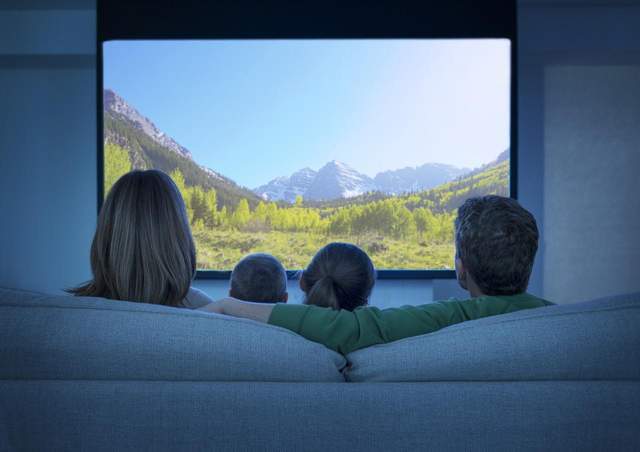TVs sold for “cabbage prices”: a minimum of several hundred yuan, 65 inches sold for one or two thousand, 85 inches down by 30%
1K
TVs are getting cheaper
“Decorator” Yang Dongdong was whetted by a TV.
It’s been less than a week since the Double Eleven pre-sale, and she is looking forward to the home appliance session in Li Jiaqi’s live room: According to the notice on Xiaohongshu, among TV products, the 75-inch Hisense E35H may be less than 4,000 yuan. At present, its official discount price is 4799 yuan, which is also the price of 6.18 this year. Yang Dongdong set aside a budget of 10,000 yuan to buy a TV. If she can buy a good 75-inch TV for less than 4,000 yuan, she can save a lot of money.
Yang Dongdong was willing to wait for Double Eleven, but Fang Yaru, who mocked herself as a “sewer” girl, didn’t wait. A Xiaomi TV that only costs 539 yuan really doesn’t need to worry about anything.
Recently, her iPad broke the screen, and it cost 500 yuan to repair. She chose the latter between sending it in for repair and buying a TV. “The money for changing the screen can buy a small TV. Not only is the TV cheaper than the iPad, but the screen is bigger than the iPad.” Fang Yaru thought about it and placed an order on Tmall. A few days later, she placed the 32-inch Xiaomi TV in a room of more than ten square meters, and she happily chased “Freesia Jue”.
“The current TV is really sold at the ‘cabbage price’. Compared with the previous 899 yuan, this Xiaomi TV is almost half discounted.” Fang Yaru sighed.
It is not only the Xiaomi family that can get a half discount. Thunderbird TV, a sub-brand of TCL, announced on the social platform that from October 17th to October 31st, the price of all products from 55 inches to 98 inches is as low as 50% off. “The price reduction is dazzling.” Lin Yue, who had already read the third wave of Thunderbird’s warm-up event on Xiaohongshu, was surprised. “This year’s Double Eleven TV has a very strong preferential atmosphere.”
Lin Yue wants to replace a new TV with a size of 85 inches or more in order to achieve the effect of “home theater”. Online, she saw that Panasonic, Samsung, Casarte and other brands have trade-in subsidy policies, with a maximum replacement price of more than 1,000 yuan. But she wasn’t in a hurry to make a decision. Between working days, Lin Yue took a stroll around Gome and Suning Tesco, not far from home, and found that the stores had more preferential activities and subsidy policies. “For example, the previous price was still around 15,000 yuan. If I go to the store to see it after a while, it’s only in the early 10,000 yuan. Other TVs that always fluctuate between seven or eight thousand yuan now also have a discount of 3,000 yuan.”
“Have a few words with the shopping guide, and the other party will enthusiastically cut off thousands of dollars.” Lin Yue was shocked by the price reduction of the TV.
Indeed, the “atmosphere responsibility” of the living room of TV has not only sold more and more since this year, but the price has also become cheaper. A few years ago, 43-inch TVs were the mainstream in the market, and the price was generally two or three thousand yuan. Now, Xiaomi’s latest 43-inch TV on the Jingdong platform is only 799 yuan after the discount is over.
On the JD.com platform, Xiaomi’s best-selling TV is a 55-inch TV, which will only cost 1,299 yuan after the latest discount in 2022, followed by a 75-inch large TV, which is only 2,999 yuan after receiving a coupon, a 65-inch TV The hand price is 1899 yuan.
Coincidentally, the price of Hisense vidda 55-inch 4k high-definition TV is also 1299 yuan, and the price of Hisense AI voice-activated TV 65-inch and 75-inch is 2349 yuan and 3099 yuan respectively.
Suning.com sells even lower. Xiaomi brand 43-inch and 55-inch TVs are 40 yuan cheaper than JD.com respectively. The top-ranked TCL metal full-screen 55-inch TVs and Hisense 65-inch TVs are also mostly priced at One or two thousand dollars. Skyworth, Hisense, TCL and other brands of 85-inch TVs can be won for five or six thousand yuan, and 75-inch TVs are generally sold for two or three thousand yuan.
This was unthinkable a few years ago. At that time, if you wanted a large 85-inch TV, you couldn’t get it without a thousand dollars. In this regard, Qi Fangying is deeply touched. In the past few years, she has witnessed the continuous decline of TV prices.
In 2010, Qi Fangying’s mother-in-law bought a 65-inch Sony TV at a cost of more than 20,000 yuan. In 2018, Qi Fangying bought electrical appliances for her newly renovated home. She still chose Sony’s 65-inch TV, but the price has dropped to around 13,000 yuan. Two years later, in 2020, when she bought a new TV for her mother, a 65-inch Sony TV could be won for only five or six thousand yuan.
(Photo/Visual China)
The specific perceptions of these consumers can also be measured with data. The information obtained from Gu Haidong, the relevant person in charge of procurement and sales of Suning.com, is that from June 18 to August 18 this year, the channel price of color wires fell by nearly 20%.
According to data from Aowei Cloud, the average price of key TV sizes has declined significantly year-on-year since the beginning of this year. The price of 70-79-inch TVs has decreased by 1,950 yuan year-on-year; the price of TVs over 80 inches has decreased by 3,470 yuan year-on-year. Among them, the most obvious decline was for 85-inch TVs. The average price in the first 13 weeks of this year fell by 26.5% year-on-year, followed by 40-inch TVs, which fell by 24.2% year-on-year. All other sizes were reduced by about 10%.
Why are TVs getting cheaper and cheaper?
The result of the superposition of multiple factors
TV prices are getting cheaper and cheaper, which is the result of a combination of multiple factors. On the one hand, the cost of raw materials is constantly falling, and on the other hand, the market demand is insufficient, so companies have to cut prices to drive sales growth.
In terms of raw material cost, the panel cost is the largest. For the production of a TV, the panel usually accounts for as high as 50% to 60% of the total cost. As one of the most important components in TV production, the fluctuation of panel prices directly affects the rise and fall of TV prices.
Industry insiders said that in the context of oversupply, panel prices have been falling since the second half of 2021, resulting in lower prices for downstream TVs.
It is understood that this round of LCD panel price slump started in July last year. An industry insider sighed that in just three months, the increase of the previous year was lost. This is just the beginning. By this year, the price of the panel has fallen below the cost price.
As of now, the price of TV LCD panels has fallen for 14 consecutive months due to reduced market demand. According to foreign media reports, the TFT55 type Open Cell (semi-finished product without backlight, etc.) used for large-size TV production was priced at about $82 per unit in September, down 2% month-on-month, and has been declining for 14 consecutive months. In May of this year, its price was still more than 100 US dollars. If the time dimension is extended, the price in October last year was even as high as 181 US dollars. The same is true for other sizes, with varying degrees of decline.
“When the panel price goes up, we follow it up, and when the panel price goes down, we follow it down,” said a Gome TV salesperson.
At the same time, the release of preferential policies or subsidies is also a factor in TVs becoming cheaper. It is understood that in the second half of this year, 13 departments including the Ministry of Commerce issued the “Several Measures on Promoting the Consumption of Green Smart Home Appliances”, and the “2022 National Home Appliance Consumption Season” was officially opened. Beijing, Jiangsu, Shandong and other places have successively launched measures such as home appliance subsidies and trade-in, to promote the demand for home appliance renewal and the active market.
Gu Haidong revealed, “The products that participate in the consumption subsidy focus on the first- and second-level energy-efficient products. Such products are of good quality and high price, and more consumers need to be able to experience them on the spot. In this way, the retail advantage of Suning’s offline stores will be greatly improved. It is even more obvious. At present, the subsidy policy is concentrated on mid-to-high-end products, which has achieved a more favorable price to meet the consumer experience’s demand for high-quality products.”
(Photo/Visual China)
However, in the long run, the slowdown in demand is still the underlying reason for the price reduction of color TVs. In the context of sluggish market sales and fierce competition, companies have adopted price cuts to drive sales growth.
In 2021, domestic color TV sales are very bleak. The annual retail sales hit a 12-year low, with only 38.35 million units sold, falling below the 40 million mark. Entering 2022, the demand for color TVs will continue to be sluggish. According to data from Aowei Cloud, the retail sales volume of color TVs in all channels in the first quarter of this year was 8.831 million units, a year-on-year decrease of 10.8%. During the May 1st promotion period, the retail sales continued to decline, with a retail scale of 5.76 billion yuan, a year-on-year decrease of 11.2%.
CMM data also shows that, affected by the trend of price reduction, the retail sales of color cables in the first half of this year still fell slightly year-on-year; offline is still under great pressure, and the year-on-year decline in volume during the big promotion is still more than double digits.
Although the market demand is weakening, the competition is becoming more and more fierce, which also affects the price trend of TVs to a certain extent.
The price war for TVs was started by LeEco. In 2013, LeEco launched a 60-inch smart TV, which was only half the price of the products of the same period, which quickly opened up the situation. In the following years, Internet TVs such as Baofeng Film and Fengxing Film and Television entered the market by virtue of their cost-effective advantages, pulling TV down from the “altar” and becoming the “price butcher” in the development of the industry. Traditional TV companies also launched sub-brands such as Coocaa, KKTV, and vidda to seize the market.
Ding, the founder of Ding Technology, believes that objectively, after the fierce competition in the Internet market, the brand concentration of the TV market has been continuously improved, and the market share of the top three top three has jumped from the previous 30 points to the current 60 points. . Some weak brands are also eliminated by the survival of the fittest, completing the market “shuffle”, and TV prices have achieved a trend of civilianization in this process.
In the few years when Internet TV entered the market and the color TV market became a dominant player, the consumer side also completed the transition from non-smart TVs to smart TVs, and the “replacement wave” released a lot of consumer demand, driving market growth. This is also a highlight moment in the color TV market. “In 2016, the market sales exceeded 50 million units.” Liu Fei, research director of AVC’s Consumer Electronics Division, recalled.
After this all-time high, consumer demand in the TV market has slowed. It is reported that the normal service life of color TVs is 7 or 8 years, but due to the low start-up rate of TVs and reduced frequency of use, the development of smart TVs has not yet ushered in a major breakthrough. On the whole, the current consumer’s willingness to switch is not strong.
“Part of the reason for the downward trend in prices is that the maturity of the TV category is increasing, consumers are buying more rationally, and the information price difference is further compressed.” Xiaomi said.
In this process, the sharp contrast is the “high-end upgrade” of smartphones. At the same time, constantly improving functions and expanding consumption scenarios also make smartphones have a great tendency to replace TVs.
Enterprises find ways to tap new growth points
From the perspective of market development, it is impossible for TV prices to maintain the “cabbage price” all the time.
Taking the panel price as an example, a signal is that according to the panel prices released by a number of market research agencies in early October, the price of 32-inch to 65-inch TV panels has stopped falling.
Omdia judges that the past September will be the end of this round of LCD TV panel price downward cycle. With the strong push of panel manufacturers, starting from October, all sizes of TV panels including 32-75 inches will usher in price increases .
As panel prices go out of the trough, will the price of color TVs in the terminal market also rise? Xiaomi said that the transmission effect will be delayed to a certain extent, and some manufacturers may not be able to resist the risk of upstream price changes and adjust prices.
Liu Buchen, a senior home appliance industry observer, said that the sales of super-large-screen TVs of 75 inches or more have accounted for nearly 40% of the current total TV sales. This trend will further expand and is expected to increase to more than half in the next three years. The sales price is expected to gradually increase as the panel supply price bottoms out next year.
Liu Fei said, “Because panel prices may rebound next year, we believe that Double Eleven will be a time node worth buying color TVs in the short term. From the perspective of shipments, color TV companies are more active in stocking.”
In addition, TV manufacturers are also learning from manufacturers of mobile phones, air conditioners, refrigerators, etc., through functional upgrades and iterations, to seek breakthroughs at the product level and tap new growth points.
Since this year, the discussion of “Art TV” and “Painting TV” in social media such as Xiaohongshu has continued to rise. Most of these products are light and thin in body, high in appearance, and strong in artistry, and are part of the home environment. To this end, Suning Audio-Visual Multimedia has connected with e-commerce manufacturers such as Samsung, TCL, Skyworth, Konka, etc. By enhancing the image of store terminals and strengthening the scene layout of “picture frame TV” integrated into home decoration style, Suning’s store experience quality has been further improved to satisfy consumers. demand for such products.
“The wall TV can not only be used as a TV, but also has the display function of decorating the home”. Gu Haidong said that Art TV is a household product that meets various consumer needs and has a certain vitality. Due to the late rise of the product, it is still in a niche category in the entire TV product and has a large market space.
Liu Fei also added that as the aesthetic attributes of TV continue to strengthen, consumers’ purchasing habits will change. Compared with the consumption nodes of replacing new houses in the past, the purchase of home appliances has been pre-planned for decoration. “We learned that many consumers will go to the designer before purchasing home appliances, and through the complete decoration plan provided by the designer, they will always choose products according to the overall style of home decoration, color preferences and other designs. In this process, color TV sets are integrated. , the scene-based consumption trend has increased.”
(Photo/Visual China)
Products such as gaming TVs with higher refresh rates and higher resolutions, and social TVs with cameras have also entered the public eye. These products will also perform well in specific sub-scenarios such as sports events and “somatosensory games”. Analysts at Soochow Securities believe that the holding of the World Cup from mid-to-late November to mid-to-late December will simultaneously promote the expansion of current sales and the increase in average size, prompting TV brands to actively stock up.
Currently, TV also has a trend of polarization. On the one hand, in this year’s price reduction, entry-level products of around 2,000 yuan have continued to increase, and they have continued to sink to the third- and fourth-tier regions; on the other hand, the market share of mid-to-high-end products represented by “big screen” has also in ascension.
Gu Haidong’s analysis said, “Take the hot-selling 55-inch TV as an example, the price of the TV manufacturer for the B-end is about 1,300 yuan, and the merchant adds 15 points or 20 points to the retail price on this basis. This price is not suitable for TV manufacturers. For example, the profit margin is extremely low, and it is more to stabilize the market size and market share; while large-screen and large-size products will have relatively more profit margins.”
It is understood that my country’s color TV product specifications are growing at a rate of 1.5 inches per year. Liu Fei introduced that at present, 75-inch TV products have grown into the third most popular size in the offline market. “There is still some room for development in the high-end market, but more product prices are popularized to the general public. The 75-inch market priced between 3,000 yuan and 6,000 yuan accounts for between 50% and 60%, which is closer to public demand. TV products above RMB also have a 10% market share.”
Gu Haidong revealed that in Suning, the monthly sales of Konka brand 98-inch single products reached 800 units. These large-screen high-end products also have a strong impetus to improve the brand image and enhance the product structure.
It can be seen that multiple favorable factors are constantly being released. Will the color TV market get better after “crossing the robbery”?






